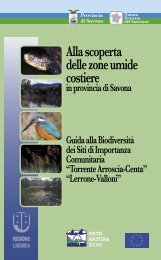Catalog of species-group names of Recent and fossil Scaphopoda ...
Catalog of species-group names of Recent and fossil Scaphopoda ...
Catalog of species-group names of Recent and fossil Scaphopoda ...
You also want an ePaper? Increase the reach of your titles
YUMPU automatically turns print PDFs into web optimized ePapers that Google loves.
Species-<strong>group</strong> <strong>names</strong> <strong>of</strong> <strong>Scaphopoda</strong> (Mollusca)APPENDIX 1Rectification <strong>of</strong> nomenclature. Renaming <strong>of</strong> homonyms.In the course <strong>of</strong> preparing this catalog, we identifieda significant number <strong>of</strong> junior homonyms.Since the majority <strong>of</strong> scaphopod <strong>species</strong> wereoriginally described in the genus Dentalium, it isnot surprising that the same <strong>species</strong> <strong>names</strong>hould be used twice, or even more <strong>of</strong>ten, forthis genus. Pilsbry & Sharp (1897-1898)renamed numerous homonyms, except for severalthat they considered to be nomina dubia orotherwise invalid (e.g., “The name is preoccupied;but as this is probably not a valid <strong>species</strong> itneed not be renamed”, Pilsbry & Sharp 1898:310).Subsequently, Emerson (1954) renamed 12 juniorhomonyms, <strong>and</strong> Palmer (1974b) renamed11 junior homonyms. These authors tartly notedthat nearly all <strong>of</strong> these homonyms “could havebeen avoided” if the authors had taken the timeto consult Pilsbry & Sharp (1897-1898) beforedescribing their new <strong>species</strong>.We have uncovered an additional 29 juniorhomonyms, 13 <strong>of</strong> which are listed below <strong>and</strong> areherein renamed. Full bibliographic data for each<strong>species</strong> is given in the main catalog. There are 11taxa that we have not renamed, although ICZN(1999) article 60.1 requires replacement <strong>names</strong>for junior homonyms that do not have an “available<strong>and</strong> potentially valid synonym”. If either thesenior or the junior homonym is a dubious<strong>species</strong> due to the lack <strong>of</strong> type material, localitydata, or proper descriptions, or if a junior synonymis available, we avoided introducing new<strong>names</strong> for probably invalid taxa. For each <strong>of</strong> thesejunior homonyms we justified our decisions inthe main catalog: Dentalium attenuatumSowerby, 1860 non Say, 1824; Dentalium ovaleCooke, 1928 non “Malm.”; Dentalium dentalisvar. aequicostata Foresti, 1895 non Dentaliumaequicostatum Koenen, 1892; Dentalium angulatumVinassa de Regny, 1897 non Buckman inMurchison, 1845; Dentalium annulatumCrist<strong>of</strong>ori & Jan, 1832 non Gmelin, 1791; Dentaliumbrevifissum Galeotti, 1837 non Deshayes,1825; Dentalium calabrum Crema, 1910 nonO. G. Costa, 1851; Dentalium conicum Seguenza,1876 non Hutton, 1873; Dentalium decemcostatumQuaas, 1902 non Brazier, 1877; Dentalium(Fustiaria) geinitzi Koenen, 1892 non Böhm,1885; Dentalium(?) giganteum Zenker, 1836 nonPhillips, 1829; Dentalium inaequicostatumDautzenberg, 1891 non Seguenza, 1879;Dentalium (Fustiaria) inversum Cossmann, 1915non Deshayes, 1825; Dentalium octogonumRayneval, Hecke & Ponzi, 1854 non Lamarck,1818; Dentalium (Entalina) mediocarinatapliocenica Koperberg, 1931 non Sacco, 1897;Dentalium rugosum Eichwald, 1857 non Dunker,1849.Furthermore, this list <strong>of</strong> renamed homonymsdoes not include the numerous subspecific-rank<strong>names</strong> <strong>of</strong> Sacco (1897) <strong>and</strong> Locard, who repeatedlyused the same name below the <strong>species</strong> level.Should a subsequent researcher recognize one <strong>of</strong>Sacco’s or Locard’s junior homonyms as beingvalid, it can then be renamed.Further, to the best <strong>of</strong> our knowledge, only one<strong>of</strong> these junior homonyms, Antalis inaequicostata(Dautzenberg, 1891) can be preserved pursuantto ICZN (1999) article 23.9.1, which allows forhomonyms that have been widely used in the literatureto be preserved if the senior name has notbeen used since 1899.Where possible, we contacted the authors <strong>of</strong> the<strong>species</strong> taxa that are junior homonyms, i.e.Rodolfo Brunet, Maria del Carmen Perrilliat <strong>and</strong>Victor Scarabino, to ascertain whether theywould prefer to rename their own homonyms.Drs Perrilliat <strong>and</strong> Scarabino kindly consented toour renaming their homonyms; no reply wasreceived from Mr Brunet, despite severalinquiries.Dentalium (Graptacme) acuticostatum Plate, 1908anon Dentalium acuticostata Deshayes, 1825. Hereinrenamed Graptacme acutistriata Steiner & Kabat,2004.ZOOSYSTEMA • 2004 • 26 (4)709




